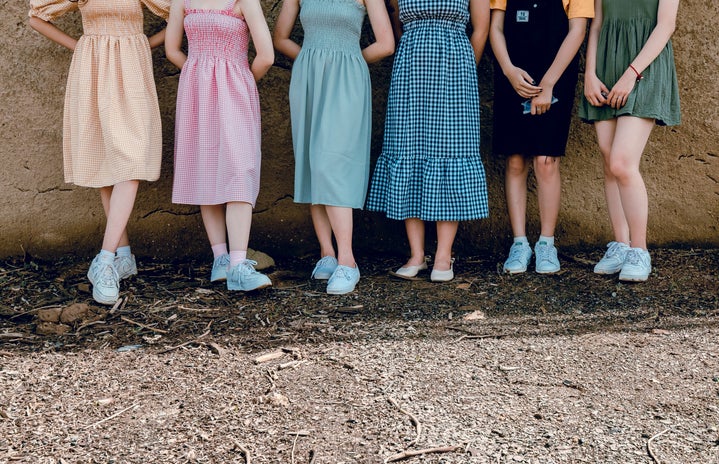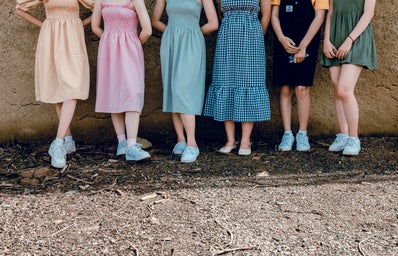If you’ve been on Tik Tok or any other social media platform in the last few months, you’ve most likely heard the name Heather at one point or another. The name Heather has popped up in various Tik Tok trends, from people lip-syncing and dancing to the popular ‘80s musical Heathers and people claiming to be her, but who exactly is Heather?
The TikTok trend
Before this year, every time I heard the name “Heather,” I always associated it with that notorious, popular high school friend group The Heathers from Heathers and Heathers: The Musical. I bet you did, too.
In 2019, there was a trend on TikTok that featured coordinating hand choreography and lip-syncing to the song “Big Fun” from the musical. However, after YouTuber-turned-singer Conan Gray released his debut album Kid Krow this past March, the entertaining Heather TikTok dance evolved into a more melancholy and solemn trend.
Conan Gray’s Kid Krow features an emotional and dismal track titled “Heather.” Based on real events, Gray’s song discusses the complexities of his high school years where he had a crush on someone, but they only had eyes for a girl named Heather. In the song, Heather is not portrayed as the stereotypical mean and popular girl described in most teen rom-coms. Instead, Gray depicts Heather as a seemingly perfect and incredibly kind person that you can’t help but like, but because the person that he likes is only interested in Heather, he can’t help but hate her at the same time.
In an interview with Genius, Gray describes Heather as the “most wonderful person you could ever meet,” asking “who isn’t in love with Heather?” He struggled to justify why he hated Heather, but he knew that he was envious of her.
In an interview with Billboard, Gray said that he “would’ve done anything to be like her,” even if it meant losing himself in the process. The music video portrays this concept in a beautiful yet dismal light as Gray traverses around his room and begins to implement more traditionally feminine elements into his appearance, such as a plaid skirt and hair clips. The video captures his process of gradually changing himself to become more like Heather.
Heather’s perspective
Since the release of Gray’s album, fans have created numerous trends related to Gray’s “Heather.” These trends include songs written and sung from Heather’s perspective and TikTok videos documenting Heather’s point of view.
Although Gray presents Heather in an ideal and perfect light, many songs and videos from Heather’s perspective point out that she is not the flawless girl he thinks she is. She has flaws and insecurities, just like the rest of us, but they aren’t as visible on the outside.
In other renditions of the song, fans created an alternate plot to the song where Heather is actually in love with Gray and only becomes close to his crush to either make Gray jealous or become closer to him.
Becoming Heather
Another popular countertrend associated with Gray’s “Heather” is the multitude of TikTok videos of claiming “____ is/was Heather,” which involves them deeming their family, friends or past selves as Heather. Because of Gray’s song, the term “Heather” has transformed from a name into a symbol of a person so perfect that you can’t help but like them. It’s evolved so far that people now commonly use it as an adjective to describe a type of person.
We all have a Heather in our lives.
In his interview with Genius, Gray points out that he was hesitant to include this song in the album because of how vulnerable he is in it. Because he depicts Heather as a perfect person, Gray felt as if he had no justifiable reasons to hate her and want her to disappear. As a result, he almost felt embarrassed discussing his envy of Heather because of the innate feeling that he was the only person that possessed such animosity for a person that has not done anything wrong.
However, this feeling of jealousy and envy is universal, and we have all felt it to a certain extent. “Heather” evokes unrequited love and the sad yet realistic effects of feeling like a second choice. Whether we want to admit it or not, we have probably felt these feelings at one point or another in our lives, even if it was on a small scale, but that makes us human. At some point, we’ve probably all had our very own Heather.
For me, especially in middle and high school, I saw Heather in many of the people around me. Whether it was their grades, kindness, social life or beauty, I could not help but see their qualities that I thought I lacked. They were everything that I wasn’t, and some nights I would let these thoughts tear me up inside.
These feelings of jealousy and envy are unavoidable, but it’s still easy to feel like we are the only ones with these negative attitudes. It’s so easy to let these thoughts spiral, which often takes us to a place in our minds that is lonely, numbing and terrifying. However, we need to remind ourselves that it’s healthy to let these thoughts out instead of bottling them up inside and allowing them to slowly take over our thoughts.
Although it takes time, we can grow through these negative thoughts. By expressing them in a healthy way like Gray did by writing his song, we can make small improvements to our mental wellbeing. It’s important to surround yourself with people that help you through the dark thoughts and feelings you may be having because no one should have to deal with them alone. And remember: Be patient with yourself as you wrestle with your internal and external conflicts. It’s okay to struggle. We all do it. You aren’t alone in your battles.



